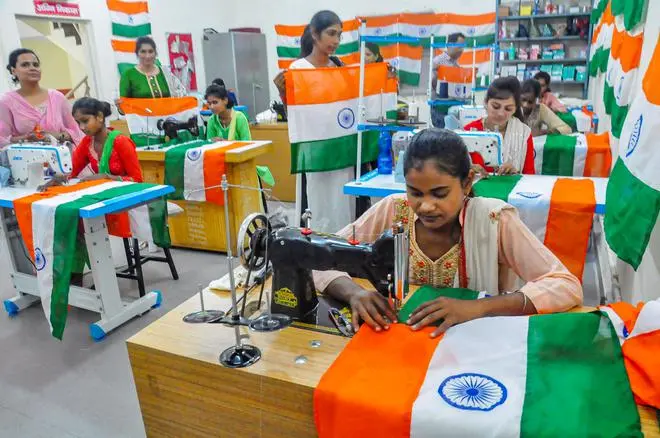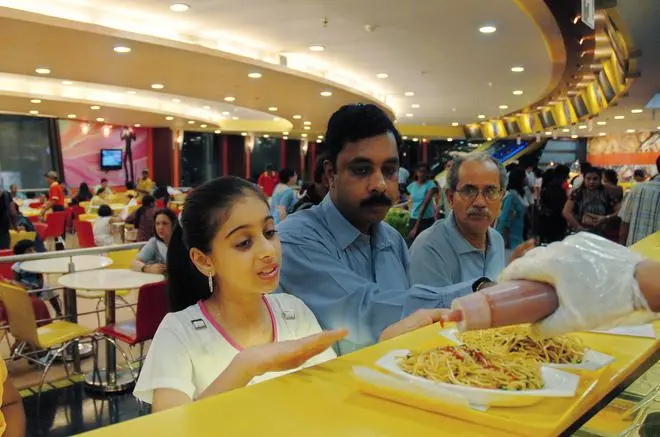India today celebrates 75 phenomenal years. Few gave the newborn nation any chance in 1947, with many arguing it would implode because nothing could unite this country of stark contrasts and seemingly irreconcilable diversity. The baggage of 584 princely states, illiteracy, lack of industry, and absence of governance foretold a recipe for disaster.
But India has progressed on many fronts. From a business management perspective, my six takeaways are:
1. India will continue to be a mass market
In the last six months, South Indian movies with catchy songs, punchy dialogues, snappy mannerisms and larger-than-life heroes have captured the imagination of the country. They have swayed the public with songs like ‘Oo Oo Antava’, ‘C’mon baby, let’s go on the Bullet’, and ‘Ra Ra Rakamma’.

S S Rajamouli's film RRR features Ram Charan and NTR | Photo Credit: SPECIAL ARRANGEMENT
While southern films have swept the country, Bollywood film-makers have lost the plot. They are trying to be slick and ape Hollywood or go niche, much like some MNCs in emerging markets. The lesson for all companies is that you will not be a scale player without a mass approach.
2. India will continue to be a branded market
India started as an unbranded, unorganised market in 1947. Over the years we developed an unorganised branded market with retail brands. India is home to the largest retail footprint in the world — we have an outlet for every 150 people. Brands played an important role in being a quality marker, plus a reason for retail to buy from manufacturers.

India is fast becoming a brand conscious market | Photo Credit: ANINDITO MUKHERJEE
Nowhere in the world does one see advertising for pipes, cement, electric bulbs, adhesives, and electric wires. The Indian mass market is brand-conscious but more value-conscious. Indian entrepreneurs continue to perceive branding as a route to enhance profitability and exit commodity trading.
3. The surge in manufacturing self-reliance

Moradabad: Women belonging to a self help group stitch tricolours for the 'Har Ghar Tiranga' campaign, in Moradabad district, Tuesday, Aug 9, 2022. (PTI Photo) (PTI08_09_2022_000223B)
In 1947, the bicycle was the largest selling durable in India. Today India is the manufacturing hub for the two-wheeler market, the small car market, generic drugs, and vaccines; it is home to one of the largest local cement markets. India has, over 75 years, developed import substitution as a goal and significantly upped quality to match global standards in every industry. Today, an impressive 30 per cent of India’s GDP is manufacturing-led.
4. Indian consumers are more local than global

A Haldiram foodcourt in Kolkata’s Gariahat
Winners in India have been brands/ companies that have understood India, its habits and taste. This is most obvious in the foods sector, where multinational brands have made little headway. Amul is the largest brand in all FMCG! The category with the maximum innovation in Mumbai city is the simple khakhra, which has about 100 variants serving every community’s taste profile, and even a mobile pack for the lady’s purse. Blindly replicating Western/Asian products or brand or messaging has failed in most cases.
5. India’s physical infrastructure may be poor, but its digital infrastructure is rich

In the last 15 years, the mobile infrastructure has been the backbone of the digital ecosystem in India. Everything in India is mobile first, not PC first or tablet first. India is the second largest start-up country because of the rich digital infrastructure and this, I predict, will only multiply. India will be a vibrant digital system in the future because of the ‘trishul’ or trident of Aadhaar, UPI, and, recently, ONDC (open network for digital commerce). This combination doesn’t exist elsewhere in the world, and this is ‘consumer delight’ at its best on the identity trust, easy payments, and competitiveness platforms.
6. India, the home of management thinkers
India has produced some of the best global management thinkers in the last 50 years — the late CK Prahalad, Ram Charan, Nitin Nohria, Sumantra Ghoshal, the late Bala Balachander, Shrikant Dater, and Vijay Govindarajan, to name a few. One can see a lot of their Indian roots in their concepts like ‘bottom of the pyramid’ and ‘rotation in a business model’. Each of them has consulted and coached Indian enterprises and Indian leaders over the years to drive global best practice in cost, quality, differentiation, and capability as the foundation of competitiveness.

Dr. C. K. Prahalad was the Harvey Fruehauf Professor of Corporate Strategy at the University of Michigan, US. (CIRCA 1995) PHOTO: THE HINDU ARCHIVES | Photo Credit: SAGGERE RAMASWAMY
India has come a long way and it will go a long way over the next 25 years. India has vitality, oodles of energy, and an attitude to make things happen. These are all good ingredients in the management space.
India can lead and the world will follow if India persists with its soft power. Management influence is more about soft power.
Shiv Shivakumar is Group Executive President, Corporate Strategy & Business Development, Aditya Birla Group







Comments
Comments have to be in English, and in full sentences. They cannot be abusive or personal. Please abide by our community guidelines for posting your comments.
We have migrated to a new commenting platform. If you are already a registered user of TheHindu Businessline and logged in, you may continue to engage with our articles. If you do not have an account please register and login to post comments. Users can access their older comments by logging into their accounts on Vuukle.